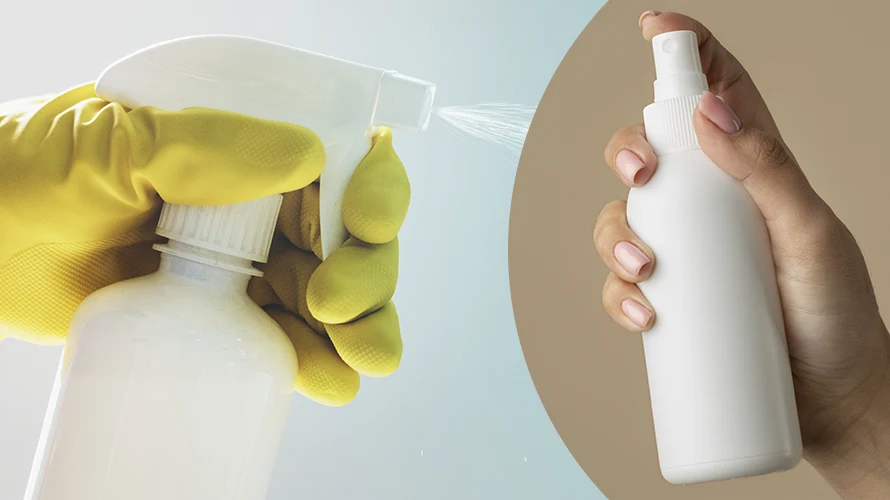A quick overview of the topics covered in this article.
Subscribe to the UKPACK newsletter to receive regular updates on the company, products, services, upcoming exhibitions and more.
Spray bottles have been around for decades and are a staple in many households. They are versatile and can be used for a wide range of applications, from watering plants to cleaning surfaces. The concept of a spray bottle is simple – it releases a fine mist or stream of liquid when you press the trigger.
But how does it work? Let’s find out.
Parts of a Spray Bottle
To understand how a spray bottle works, it’s important to know its parts. The main components of a spray bottle include the trigger sprayer, nozzle, dip tube, check valve, and bottle body.
- Trigger Sprayer: This is the part of the spray bottle that you press to release the liquid. It is typically made of plastic and consists of a piston, which creates pressure when pressed, and a trigger, which activates the release of the liquid.
- Nozzle: The nozzle is the opening at the end of the trigger sprayer that releases the liquid in a fine mist or stream. It can be adjusted to control the direction and flow of the liquid.
- Dip Tube: This is a long, narrow tube that extends from the trigger sprayer to the bottom of the bottle. When you press the trigger, it draws the liquid up through the dip tube.
- Check Valve: The check valve is a small, one-way valve that is located at the bottom of the dip tube. It prevents the liquid from flowing back into the bottle after it has been drawn up through the dip tube.
- Bottle Body: The bottle body is the container that holds the liquid. It can be made of plastic, glass, or other materials.
How Does a Spray Bottle Work
The mechanics behind a spray bottle are relatively simple. When you pull the trigger, it releases pressure in the bottle, which allows the liquid to flow up the dip tube and into the nozzle. As the liquid passes through the nozzle, it is released in a fine mist or stream. The check valve prevents the liquid from flowing back into the bottle, ensuring that it is ready for the next use.
Different Types of Spray Bottles
There are several types of spray bottles available, each with its own unique features and benefits. Some of the most common types include:
- Continuous Spray Bottle: This type of spray bottle uses a pump mechanism to release a continuous mist of liquid.
- Compressed Air Sprayer: Compressed air sprayers use compressed air to release the liquid in a fine mist or stream.
- Pump Sprayer: Pump sprayers require manual pumping to pressurize the bottle and release the liquid.
Maintenance and Troubleshooting Tips
To keep your spray bottle working properly, it’s important to perform regular maintenance and troubleshoot any issues that arise. Here are some tips to help you keep your spray bottle in top condition:
- Cleaning the Spray Bottle: Regular cleaning can help prevent clogs and keep your spray bottle working effectively. To clean the bottle, remove the trigger sprayer and rinse the bottle and nozzle with warm, soapy water. Rinse thoroughly and allow to dry before reassembling.
- Fixing a Clogged Nozzle: If the nozzle becomes clogged, try soaking it in hot water or using a needle to unclog the opening.
- Replacing Parts: If a part of your spray bottle becomes damaged or worn, it may need to be replaced. Most parts, including the trigger sprayer, nozzle, and check valve, can be easily replaced and are available at hardware stores or online.
- Adjusting the Nozzle: If you want to adjust the flow or direction of the liquid, you can adjust the nozzle by turning it to the desired position.
- Avoiding Corrosion: If you are using a spray bottle with acidic or corrosive liquids, it’s important to choose a bottle made of a material that is resistant to corrosion, such as glass or high-density polyethylene (HDPE).
Conclusion
In conclusion, a spray bottle is a simple but effective tool that can make many tasks easier. By understanding its components and mechanics, you can choose the right type of spray bottle for your needs and keep it working properly for years to come. Regular maintenance and troubleshooting can help prevent clogs and damage, ensuring that your spray bottle is always ready when you need it. We hope that this comprehensive guide has helped you better understand how a spray bottle works and how to maintain it for optimal performance.
Luxury Skincare Packaging: A Comprehensive Guide
Welcome to the captivating world of luxury skincare packaging! Whether you’re a brand owner or a beauty enthusiast, understanding the nuances of packaging can elevate your skincare game. In [...]
Creative Sunscreen Packaging Ideas: Boost Your Brand
Sunscreen is essential for skin protection, but let’s face it—its packaging can make or break a customer's first impression. In a saturated market, having creative and effective sunscreen packaging [...]
The 25 Best Hair Care Brands of 2024
Welcome to the ultimate guide to the best hair care brands of 2024! Whether you're on the hunt for products that will give you luscious locks or looking to [...]




